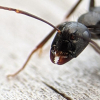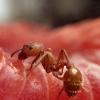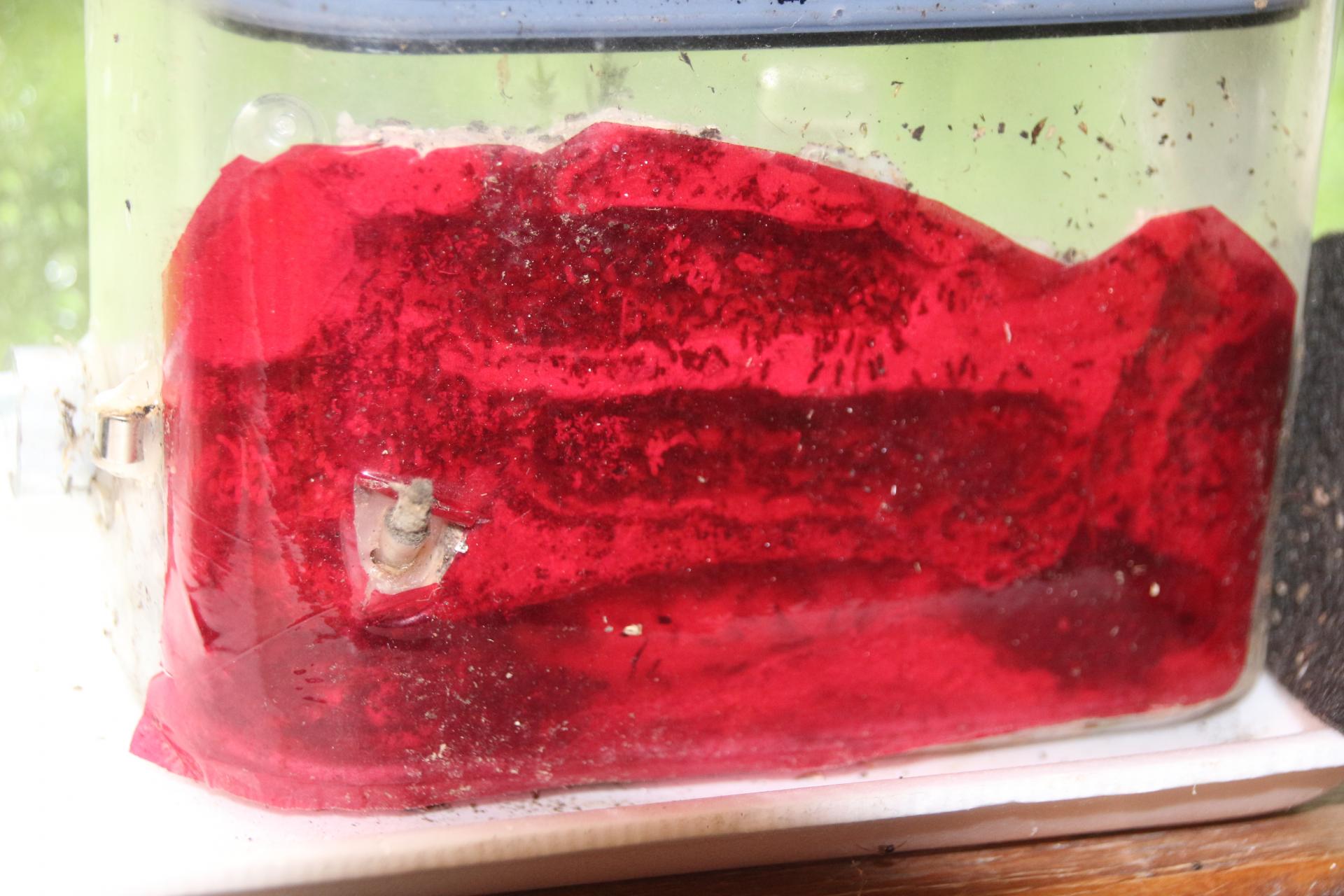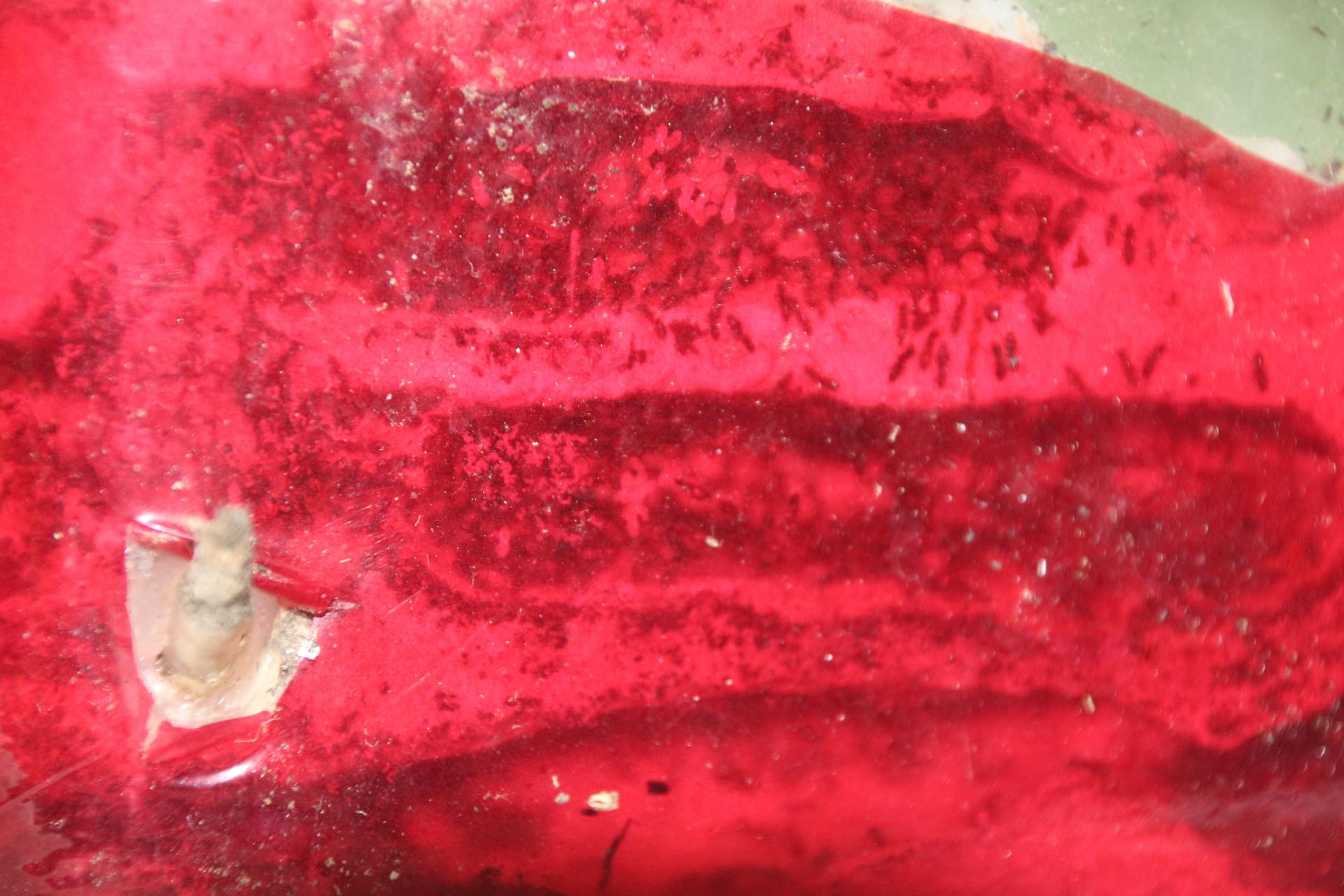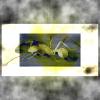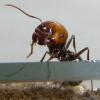- Formiculture.com
- Forums
- Gallery
- Members
- Member Map
- Chat

Easiest ants to keep (Long term)
Started By
futurebird
, Jul 25 2024 3:55 PM
18 replies to this topic
#1
 Offline
-
Posted July 25 2024 - 3:55 PM
Offline
-
Posted July 25 2024 - 3:55 PM
Often Lasius sp. ants are recommended to newbies because they are tolerant and hearty and grow rather quickly. Likewise, in the US Pogonomyrmex are also starter ants since they can't climb glass and are easy to feed without raising insects. (They do, however, sting, which always seemed like it should have mattered more... they are not super aggressive about it... but still.)
Camponotus species come with the caution "they grow slowly" and ... this isn't true of all carpenter ants. Camponouts discolor and decepins grow quickly... but larger carpenter ants do start out slow, and the colony can fail in the first year for a bunch of reasons.
But, when you get into years 3+ this slow growth becomes more of a joy. You don't feel like they are getting out of control. And Camponotus pennsylvanicus are by far my favorite colony to interact with. They don't climb very well, so cleaning is easy. And when I pick up their water feeder to refill it they hop off when I shake it. My other carpenter ants are so stubborn about this it's always a bit nerve wracking to clean and fill their feeders. I worry I will hurt them or they will get out as I struggle to get them off of the feeder.
So, for me, Camponotus pennsylvanicus is the ideal low-effort pet ant colony. If I could only have one kind of ant I think I'd go with them. I do think urea supplements are important as you get to year 2-- and they benefit from extra space and natural food. But these things aren't too hard and they have been a joy.
Which ants do you find to be the "easiest" for longer term colonies?
Starting this July I'm posting videos of my ants every week on youTube.
I like to make relaxing videos that capture the joy of watching ants.
If that sounds like your kind of thing... follow me >here<.
#2
 Offline
-
Posted July 25 2024 - 4:11 PM
Offline
-
Posted July 25 2024 - 4:11 PM
I haven’t ever raised a colony more than a month or two but from my knowledge camponotus would probably be easiest in my opinion.
The ants go marching.
Currently keeping:
#3
 Offline
-
Posted July 25 2024 - 5:16 PM
Offline
-
Posted July 25 2024 - 5:16 PM
I've kept a Pogonomyrmex Occidentalis colony for 16 months (from 28 to around 400).
I've not been stung yet. I have had them get on me with some regularity, though i am cautious.
I think they have been super easy to keep and interesting to watch.
I have gotten good with butterfly tweezers for picking them off water towers, old fruit or whatever i'm cleaning out.
A good pair of long handled reverse tweezers is useful too. i often use those to grab things i want to take out like empty water towers, and the butterfly tweezers to take ants off.
And i'd agree with you that at around 400 in just 14 months, and growing steady. They are getting a little scary. I suspect the next big change up i do to their setup is going to be challenging on containment during remodeling.
Edited by Full_Frontal_Yeti, July 25 2024 - 5:17 PM.
- futurebird likes this
#4
 Online
-
Posted July 26 2024 - 7:06 PM
Online
-
Posted July 26 2024 - 7:06 PM
Often Lasius sp. ants are recommended to newbies because they are tolerant and hearty and grow rather quickly. Likewise, in the US Pogonomyrmex are also starter ants since they can't climb glass and are easy to feed without raising insects. (They do, however, sting, which always seemed like it should have mattered more... they are not super aggressive about it... but still.) Camponotus species come with the caution "they grow slowly" and ... this isn't true of all carpenter ants. Camponouts discolor and decepins grow quickly... but larger carpenter ants do start out slow, and the colony can fail in the first year for a bunch of reasons. But, when you get into years 3+ this slow growth becomes more of a joy. You don't feel like they are getting out of control. And Camponotus pennsylvanicus are by far my favorite colony to interact with. They don't climb very well, so cleaning is easy. And when I pick up their water feeder to refill it they hop off when I shake it. My other carpenter ants are so stubborn about this it's always a bit nerve wracking to clean and fill their feeders. I worry I will hurt them or they will get out as I struggle to get them off of the feeder. So, for me, Camponotus pennsylvanicus is the ideal low-effort pet ant colony. If I could only have one kind of ant I think I'd go with them. I do think urea supplements are important as you get to year 2-- and they benefit from extra space and natural food. But these things aren't too hard and they have been a joy. Which ants do you find to be the "easiest" for longer term colonies?
I have two words for you my friend:
Tetramorium. immigrans.
Short of dumping them out and stepping on them or microwaving them they're practically impossible to kill.
- ANTdrew, Ants_Dakota, eea and 2 others like this
"God made..... all the creatures that move along the ground according to their kinds (including ants). And God saw that it was good. Genesis 1:25 NIV version
Keeping:
Tetramorium immigrans Camponotus vicinus, modoc, novaeboracensis, herculeanus
Formica pallidefulva, argentea Solenopsis molesta
Formica cf. aserva Lasius brevicornis, neoniger
#5
 Offline
-
Posted July 26 2024 - 9:50 PM
Offline
-
Posted July 26 2024 - 9:50 PM
I have two words for you my friend:
Tetramorium. immigrans.
Short of dumping them out and stepping on them or microwaving them they're practically impossible to kill.
They should literally be the default beginner ant for all antkeepers. They eat virtually everything, grow fast with/without heat, are extremely hardy, and can be found throughout most of the US.
- RushmoreAnts likes this
"Float like a butterfly sting like a bee, his eyes can't hit what the eyes can't see."
- Muhammad Ali
Check out my shop and Formica journal! Discord user is bmb1bee if you'd like to chat.
Also check out my YouTube channel: @bmb1bee
#6
 Offline
-
Posted July 27 2024 - 4:06 PM
Offline
-
Posted July 27 2024 - 4:06 PM
I’ve never been able to find any tetras, maybe it’s because of where I live.They should literally be the default beginner ant for all antkeepers. They eat virtually everything, grow fast with/without heat, are extremely hardy, and can be found throughout most of the US.I have two words for you my friend:
Tetramorium. immigrans.
Short of dumping them out and stepping on them or microwaving them they're practically impossible to kill.
Edited by cooIboyJ, July 27 2024 - 4:07 PM.
The ants go marching.
Currently keeping:
#7
 Online
-
Posted July 27 2024 - 4:17 PM
Online
-
Posted July 27 2024 - 4:17 PM
I’ve never been able to find any tetras, maybe it’s because of where I live.
Doesn't seem like they're really a desert species.
"God made..... all the creatures that move along the ground according to their kinds (including ants). And God saw that it was good. Genesis 1:25 NIV version
Keeping:
Tetramorium immigrans Camponotus vicinus, modoc, novaeboracensis, herculeanus
Formica pallidefulva, argentea Solenopsis molesta
Formica cf. aserva Lasius brevicornis, neoniger
#8
 Offline
-
Posted July 30 2024 - 2:30 PM
Offline
-
Posted July 30 2024 - 2:30 PM
Dear futurebird;
I've enjoyed reading your posts and watching your videos. I agree that Camponotus pennsylvanicus and Tetramorium immigrans are very resilient and hardy ants to keep. Probably their biggest advantage is mine can survive quite nicely with little hydration and simply drinking water. This eliminates the potential to lose a colony when you forget to hydrate them or go away on vacation, and they dry out. They also accept a wide variety of foods, many of which come off my dinner plate, making them easy to feed. I have colonies of both types that I've kept for four seasons. They've all overcome hardships and bounced back proving to me that they're resilient and make good candidates for a long-term colony.
I also have three Tapinoma sessile colonies that I've kept for four seasons. These ants, I feel, are the most underrated ants that can be kept. No fooling! Their common name "Odorous House Ant" really does them a disservice so in this age of enlightenment I call mine "Fragrant House Ants". The colonies I keep have all the desirable characteristics noted above, but they have the added advantage of being easy to obtain. They're also easily contained with heavy mineral oil. The only problem I ran into with one colony was when they produced a large crop of alates, the workers were severely depleted. The other colonies have all kept to a reasonable size in their formicaria. I've never experienced the horror stories of raiding of other colonies, or even any serious escape attempts. They seem to be happy just doing their ant thing and I really enjoy just watching them.
I obtained all of these Tapinoma colonies by luring/capturing them in my lawn and garden. I really don't need any more colonies, but just for fun, I thought I'd see what I could collect this year. I knew the general location of a Tapinoma colony that lived around my picnic table last summer. I also knew they were fairly mobile because I'd seen the whole colony last year, when they moved under a sundial that was warmed by the sun. The whole colony was there, queens, eggs etc. So, this year I put a used formicarium under the table in a spot that would get some sun, but not get baked. We'd had a lot of rain, and they were moving brood into it within a day. We had two beautiful sunny days and they had lots of time to explore, because on the third day we had torrential downpours, one after another, to the point where everything was saturated. I knew that if there was ever going to be a time when the whole colony was in the formicarium, this would be it, so I plugged up the entrances and brought them inside. The photos below show the colony, moved in, tending brood, and queens are there because I see eggs in the top, left hand corner. This may offend purists who feel colonies should only be raised from queens, I do that too, but having an instant colony to occupy the ant lover while those queens do their work certainly makes ant keeping more interesting in the early years.
There are a few other characteristics that make these ants a pleasure to keep. They don't seem to mind light in the nest, but queens need a dark secluded place to lay and tend their eggs, so you may not see much of them, the rest of the colony will make up for it as they are very active inside and outside of the nest. They will readily transport pupae to a heat source during the day, and then return them to the nest at night. I enjoy watching them, especially on sunny days, and I think, this is a critical aspect of keeping a colony long term. Call it entertainment if you like, but I'll keep one of my active colonies that gives me something to watch, even when I'm in a nursing home!
If you have Tapinoma ants in your yard, you may be able to lure some into a trap. Some people can set one up in their own home. Putting a small test tube of sugar/water inside will be guaranteed to attract something and there may be other kinds of ants equally as mobile as Tapinoma, but I'm sure these girls are resilient and will still be around after the next meteorite making them an excellent candidate for your long-term colony.
RPT
- ANTdrew, RushmoreAnts, futurebird and 2 others like this
My father always said I had ants in my pants.
#9
 Offline
-
Posted July 30 2024 - 5:27 PM
Offline
-
Posted July 30 2024 - 5:27 PM
Besides being hardy, I’d rank how clean the species is and how hard they are to contain(escape artist) up there as part of the criteria.
Pogonomyrmex, the only drawback for me is they are a bit messy in they poop anywhere and everywhere especially on glass. Other than that they are a really good species for beginners as long as you’re careful to avoid getting stung.
I’m actually impressed how clean Honeypots are comparatively. They are meticulous in bringing trash out.
Pogonomyrmex, the only drawback for me is they are a bit messy in they poop anywhere and everywhere especially on glass. Other than that they are a really good species for beginners as long as you’re careful to avoid getting stung.
I’m actually impressed how clean Honeypots are comparatively. They are meticulous in bringing trash out.
- futurebird likes this
#10
 Offline
-
Posted July 30 2024 - 6:13 PM
Offline
-
Posted July 30 2024 - 6:13 PM
I’ve never been able to find any tetras, maybe it’s because of where I live.
Doesn't seem like they're really a desert species.
you can find those in deserts. a whole bunch of those flew last week here in AZ. i keep seeing them closely associated with brachymyrmex patagonius
#11
 Online
-
Posted July 31 2024 - 2:20 AM
Online
-
Posted July 31 2024 - 2:20 AM
You know how I feel about Tapinoma sessile, RPT! They sure are resilient. It took me weeks and a lot of flak from my wife to get rid of the free range colonies I had in my bathroom and kitchen this summer!
- RushmoreAnts, Ants_Dakota, futurebird and 2 others like this
"The ants are a people not strong, yet they prepare their meat in the summer." Prov. 30:25
Keep ordinary ants in extraordinary ways.
Keep ordinary ants in extraordinary ways.
#12
 Offline
-
Posted August 1 2024 - 2:03 AM
Offline
-
Posted August 1 2024 - 2:03 AM
Hello ANTdrew;
Hilarious!
I have to admit, I did write that post somewhat tongue in cheek, but everything I said in it is true. I used to think that your feelings about Tapinoma sessile were unreasonable, but the more I thought about it, the more I realized how much I agree with you. Throughout my life I've done battle with carpenter ants at the cottage, pavement ants on the patio and house ants in the kitchen. I've poisoned ants in my house and outbuildings. We try to have a live and let live policy with all forms of life on our property but when something becomes a nuisance, it has to be controlled. That goes for everything from ants to racoons! For example, when I put an ant colony out in my greenhouse, I found out there were three other Camponotus colonies living in the vicinity. Controlling the pest ants probably saved my pet ants and the building.
Tapinoma sessile ants have many characteristics that make them an adaptable, resilient pest. They'll live anywhere, eat anything, forage constantly and return often to places where they have found food before. They have multiple queens, so lots of hungry brood looking for food and water, therefore, kitchens and bathrooms. They can also survive quite nicely in dry conditions; your home is the perfect place.
An incident the other day showed me an important distinction. My Camponotus ants never escape, but five of them managed it the other day and I surprised them enjoying an apple that was intended to be part of their supper. I've never seen them scrambling around like that on my workbench before. I couldn't believe how quickly they went from pet to pest. Around here escapees are disposed of because they've crossed a line and are now pests. It's wise to remember that the ants I enjoy watching so much in my formicaria are the same ants that hollowed out my pine tree out back, crashing it to the ground. I love Camponotus as a pet but kill them when a pest.
What I'm getting at is that I think you should keep a colony of Tapinoma sessile as pets and you might see them in a different light when they're not being pests. The same traits that make them such a formidable pest are the same ones that make them great ants to keep. They're easy......just feed them kitchen scraps!!
RPT
- ANTdrew, RushmoreAnts, eea and 1 other like this
My father always said I had ants in my pants.
#13
 Offline
-
Posted August 1 2024 - 11:17 AM
Offline
-
Posted August 1 2024 - 11:17 AM
I have no experience with Tetramorium, but my Camponotus floridanus have been pretty easy to take care of and hardy. Of course, as a new ant keeper there are things to learn and mistakes will happen as you gain experience.
C. floridanus seems to me a good compromise where they are big enough to see well, grow faster than most Camponotus, and coming from a southern climate they are active all year round. I do give them mild heat but I don't think it's required.
Regarding escapees while cleaning, the best tip I've found is to chill them for a while before doing maintenance. 20 minutes in the fridge will slow them down and most of them go underground to the nest area (mine live in a Tarheel Mini-Hearth) so that it's easy to do whatever you need. Today I noticed a discoloration under their liquid feeder, so I chilled them a bit, plugged the hole to the outworld, and used butterfly forceps to move the last 3 ants to a glass jar and close the lid. Then I was able to clean the discolored spot with a toothbrush, refill all their stuff, drop the last 3 guys back in and everything is done without risk.
As my ants are going to want a bigger home soon I'm considering if I want to get a new colony to take over their Mini-Hearth. Pogonomyrmex is one possibility though I'm wary of the sting risk, so I'm also looking at other Camponotus - probably C. pennsylvanicus or another large species like C. castaneus. I'm not sure about smaller ants like T. immigrans. Honestly I'm having trouble picturing how it would be to watch them since they are so small. Perhaps there is some tipping point where you stop seeing them as individuals like Camponotus and they sort of become a "wave" of tiny bodies moving in lines? No idea, I probably need to go watch some YouTube videos of smaller species. We do have some sort of Tetramorium in our kitchen but I only ever see them as singles scouting around. Also, C. pennsylvanicus were our standard outdoor ant back when I was a kid so I'm somewhat partial to them for that reason too.
#14
 Offline
-
Posted August 1 2024 - 11:40 AM
Offline
-
Posted August 1 2024 - 11:40 AM
I would say Lasius niger or Tetramorium immigrans is the easiest ants to keep by a mile. Camponotus i would differ because even though they are easy to keep, they still have these random collapses that you cannot prevent and the two species I said are really adaptable and they live in so many countries for a reason
Currently keeping:
1x Formica subsericea, 35-40 workers + maybe eggs *New* 2x Camponotus nova, one has only larva
1x Crematogaster cerasi, All workers is ded ![]() *extreme internal screaming* 1x Myrmica ruba sp around 10 workers + pupa
*extreme internal screaming* 1x Myrmica ruba sp around 10 workers + pupa
*New* 1x Temnothorax curvispinosus, 101 or something worker + 3 or 4 royal mom ants + pile of white ant worms
*As you watch your ants march, remember that every thing begins with a small step and continued by diligence and shared dreams* -A.T (which is Me)
Sadly due to unforeseen consequences, I will soon be giving away my colonies (I will miss them though ![]() )
)
#15
 Offline
-
Posted August 2 2024 - 6:59 PM
Offline
-
Posted August 2 2024 - 6:59 PM
Veromessor pergandei or andrei.
1. No feeder insects to keep/buy/kill/cut up. Just buy seeds. Heck, you can feed them dandelion seeds from your own yard.
2. No sugar water requirements. No messy sugar feeders. No worry about gooey honey. No angry ants going on strike demanding sugar water.
3. No diapause really required (though a winter break supposedly is good - what I heard from someone else and it's what I do)
4. No sting!! Not a Pogonomyrmex!
5. Not as small nor as attack-all-your-other-colonies as Tetramorium
The only downside:
6, Needs heat in summer. And because of the high heat:
7. May run out of water faster.
8. Unlike Pogonomyrmex, they can climb.
Edited by OhNoNotAgain, August 2 2024 - 7:03 PM.
- eea, bmb1bee and cooIboyJ like this
Past & Present
Veromessor pergandei, andrei, stoddardi; Novomessor cockerelli
Camponotus fragilis, Camponotus sansabeanus (inactive), vicinus, laevigatus/quercicola, CA02
Pogonomyrmex subnitidus, P. californicus (inactive)
Liometopum occidentale (inactive); Prenolepis imparis; Myrmecocystus mexicanus (inactive); Tetramorium sp. (inactive); Lasius sp.
Termites: Zootermopsis angusticollis, and a box of drywood termites that can't be seen
Isopods: (most no longer keeping) A. gestroi, granulatum, kluugi, maculatum, vulgare; C. murina; P. hoffmannseggi, P. haasi, P. ornatus; V. parvus, P. pruinosus, T. tomentosa
Spoods: (no longer keeping) Phidippus sp., other
#16
 Online
-
Posted August 3 2024 - 2:15 AM
Online
-
Posted August 3 2024 - 2:15 AM
And,Veromessor pergandei or andrei.
1. No feeder insects to keep/buy/kill/cut up. Just buy seeds. Heck, you can feed them dandelion seeds from your own yard.
2. No sugar water requirements. No messy sugar feeders. No worry about gooey honey. No angry ants going on strike demanding sugar water.
3. No diapause really required (though a winter break supposedly is good - what I heard from someone else and it's what I do)
4. No sting!! Not a Pogonomyrmex!
5. Not as small nor as attack-all-your-other-colonies as Tetramorium
The only downside:
6, Needs heat in summer. And because of the high heat:
7. May run out of water faster.
8. Unlike Pogonomyrmex, they can climb.
9. Not available in most of America.
- eea and cooIboyJ like this
"The ants are a people not strong, yet they prepare their meat in the summer." Prov. 30:25
Keep ordinary ants in extraordinary ways.
Keep ordinary ants in extraordinary ways.
#17
 Online
-
Posted August 3 2024 - 7:12 PM
Online
-
Posted August 3 2024 - 7:12 PM
I would say Lasius niger or Tetramorium immigrans is the easiest ants to keep by a mile. Camponotus i would differ because even though they are easy to keep, they still have these random collapses that you cannot prevent and the two species I said are really adaptable and they live in so many countries for a reason
Most niger-like Lasius in North America are actually neoniger, pallitarsis, crypticus, or americanus, with the exception of some invasive populations in Canada and New York. I would agree the aforementioned Lasius species as well as Tetramorium and Tapinoma sessile are all excellent candidates for this title. Another species I'd like to mention is Solenopsis molesta. They may be too tiny for many ant keepers, but they're hardy, fast-growing, stupidly polygynous, and eat anything. If you have a macro lens for an eye and a heart for small species, they are also an outstanding choice.
- rptraut likes this
"God made..... all the creatures that move along the ground according to their kinds (including ants). And God saw that it was good. Genesis 1:25 NIV version
Keeping:
Tetramorium immigrans Camponotus vicinus, modoc, novaeboracensis, herculeanus
Formica pallidefulva, argentea Solenopsis molesta
Formica cf. aserva Lasius brevicornis, neoniger
#18
 Offline
-
Posted August 3 2024 - 11:16 PM
Offline
-
Posted August 3 2024 - 11:16 PM
And,Veromessor pergandei or andrei.
1. No feeder insects to keep/buy/kill/cut up. Just buy seeds. Heck, you can feed them dandelion seeds from your own yard.
2. No sugar water requirements. No messy sugar feeders. No worry about gooey honey. No angry ants going on strike demanding sugar water.
3. No diapause really required (though a winter break supposedly is good - what I heard from someone else and it's what I do)
4. No sting!! Not a Pogonomyrmex!
5. Not as small nor as attack-all-your-other-colonies as Tetramorium
The only downside:
6, Needs heat in summer. And because of the high heat:
7. May run out of water faster.
8. Unlike Pogonomyrmex, they can climb.
9. Not available in most of America.
Yeah, it's true, though at the rate ant species are becoming available with permitted shipping, it may not be long before they are.
Past & Present
Veromessor pergandei, andrei, stoddardi; Novomessor cockerelli
Camponotus fragilis, Camponotus sansabeanus (inactive), vicinus, laevigatus/quercicola, CA02
Pogonomyrmex subnitidus, P. californicus (inactive)
Liometopum occidentale (inactive); Prenolepis imparis; Myrmecocystus mexicanus (inactive); Tetramorium sp. (inactive); Lasius sp.
Termites: Zootermopsis angusticollis, and a box of drywood termites that can't be seen
Isopods: (most no longer keeping) A. gestroi, granulatum, kluugi, maculatum, vulgare; C. murina; P. hoffmannseggi, P. haasi, P. ornatus; V. parvus, P. pruinosus, T. tomentosa
Spoods: (no longer keeping) Phidippus sp., other
#19
 Offline
-
Posted August 4 2024 - 1:58 AM
Offline
-
Posted August 4 2024 - 1:58 AM
From my personal experience, Lasius niger.
They do not stress easily, recover fast even if I take brood out for fish food, are happy at room temperature, eat anything, are always busy and there is always something going on.
The list goes on.
This is why this species is recommended everywhere as the perfect beginner species.
Only downside- they are small.
And yes, the Camponotus which I keep are also easy and low maintenance, but they are not active at all and just chill in their nest, except if there is fresh food, then they come out. They are bigger, but much less exciting for kids, for example.
- RushmoreAnts, rptraut and Mushu like this
1 user(s) are reading this topic
0 members, 1 guests, 0 anonymous users


